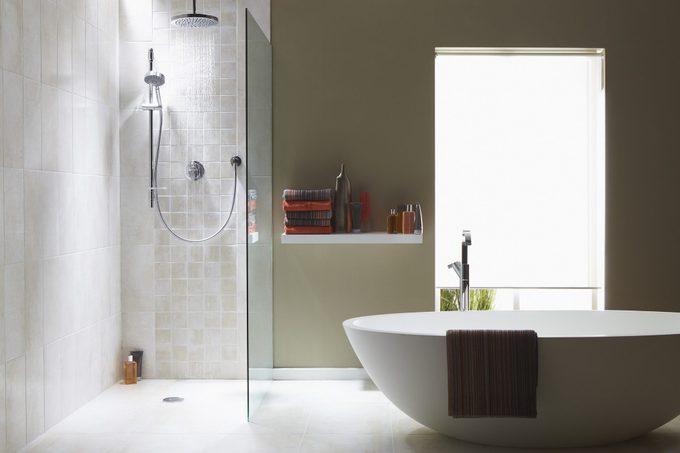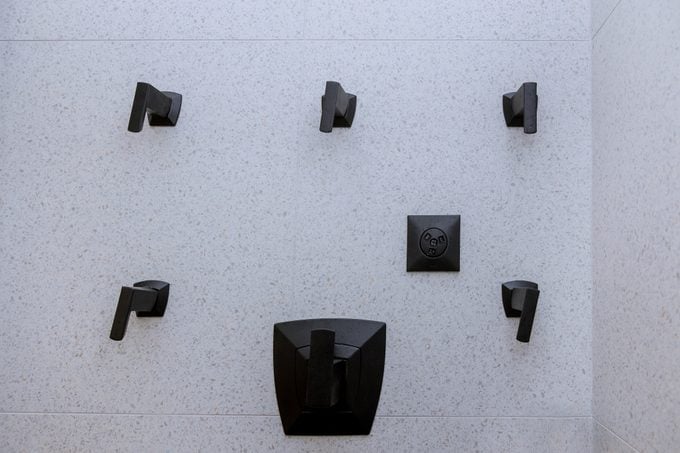16 Types of Showers for Your Bathroom
The practice of showering is as old as waterfalls, though people without a natural cascade near their home have relied on other types of showers throughout the ages.
Historically, showers have ranged from clay urns wielded by Egyptian servants to Roman public showers fed by aqueducts to the first mechanical shower, powered by a hydraulic pump and invented by a stove manufacturer from London in 1767.
Today’s homeowners have their choice of showers. Water delivery systems, including faucets and showerheads, are as diverse as the enclosures where you can retreat to enjoy the soothing, cleansing water. It pays to know what’s available before selecting a type of shower for your bathroom, basement or anywhere else you’re planning to install one.
Bathtub/Shower Combo
Because a bathroom with a bathtub already has the necessary plumbing for a shower, it makes sense that bathtub/shower combos were the first to become popular. And they still make sense today.
They require no modification to the bathroom other than installing a faucet to divert water from the tub spout to the showerhead, and enclosing the tub to keep the rest of the bathroom dry. Another option installing a handheld shower to a tub-only faucet. You simply replace the spout with one that has a built-in outlet and diverter.
Custom Shower
Custom showers fit in odd spaces. While shower dimensions can be as big as you want, code mandates a minimum floor space of 30 inches square — 36 inches square to be ADA compliant.
As the name implies, custom showers are built from scratch, starting with a mortar bed and waterproof cement board sheathing on the walls. Ceramic tile is the most common floor covering. You can cover the walls with tiles or waterproof wall panels (also called wet panels) made of fiberglass, acrylic, solid-surface material or stone.
Prefabricated Shower
Budget-conscious homeowners and those on short construction timelines often opt for prefabricated showers, which come from the supplier ready to be dropped into a pre-framed alcove. Most prefab shower stalls are made of molded fiberglass or acrylic. They come as a unit or in three or five sections assembled on site.
Stand-Up Shower
Want to put a shower in the basement or a space lacking bathroom plumbing? A stand-up shower, also known as a freestanding shower, is your best bet. It requires no framing, and you can set one anywhere you can install a drain and water supply plumbing.
Walk-In Shower

A standard shower pan has a curb in the front that prevents water from spilling out. Eliminate the curb and you have a walk-in shower that’s more accessible for the disabled and senior citizens. The absence of a curb means bathroom flooring must be waterproof and meet the shower pan at the exact same level.
Corner Shower
A space-saving option for small bathrooms, a corner shower consists of a pair of glass panels that extend from a corner of the bathroom to form a square enclosure. One of the panels incorporates a pivoted door. You can install one with a prefab shower pan or you build your own pan.
Neo-Angle Shower
A neo-angle shower is also built into a corner of the bathroom, only with three glass panels instead of two. Two panels meet the back walls and extend far enough to accommodate a third panel that has the door. The resultant polygon shape is more sophisticated than the square shape of a corner shower and better complements higher-end bathroom design.
A curved enclosure is a variation on the neo-angle shower. It has curved glass panels and a curved shower pan that add contemporary flair to any bathroom.
Rectangular Shower
A rectangular shower stall offers more room to move around than a square one. It allows you to get out of the shower spray while soaping up. It’s especially helpful for those in wheelchairs because it provides more room to maneuver.
Waterfall Shower
You can install a waterfall showerhead in any type of shower stall. By delivering a wide stream of water, it invokes the primordial experience of standing under an actual waterfall or — because the water is hot — a natural hot spring. It’s not for drought-prone areas because it dispenses water extravagantly.
Rainfall Shower
A rainfall showerhead mounts on a pipe that extends perpendicular to the shower wall. The showerhead points toward the ground and delivers a generous flow reminiscent of a rain shower. Like a waterfall shower, it’s not a water-conserving fixture.
Steam Shower
Consisting of a steam generator and a moisture-sealed enclosure, a steam shower is the ultimate in luxury. More than any other type of shower, this one calls for professional installation. All that steam can wreak havoc on the bathroom if it gets out of the enclosure.
Body Shower

Why settle for a single overhead showerhead when you can have multiples mounted on the shower walls, immersing your entire body in massaging water spray? A body shower can actually save water by delivering it exactly where it’s needed, so you don’t have to wait for it to drip down from above.
Shower Tower
A shower tower incorporates a showerhead, faucet controls, body jets, and even a hand shower in a metal column that mounts on the surface of the wall. Requiring only hot and cold supply lines, it eliminates the need to cut into the wall to install a conventional shower faucet.
On-Demand Shower
Popular in Europe where they’re called electric showers, on-demand showers consist of an electric water heater with attached showerhead mounted to the shower wall. Hook it up to a cold water supply and use the temperature control to get a pleasantly warm shower while conserving water and electricity.
Smart Shower
Set your preferred water temperature, flow rate and shower duration from a central control panel. Or have your digital assistant do it for you.
Solar Shower
Hook up a solar shower to a garden hose and fill the reservoir, which can be a bag that you hang in a tree or a black cylinder that encloses the shower stand. Wait for the sun heat up the water, then use the mixing controls to take a comfortably warm outdoor shower at your favorite campsite or in your backyard.
No comments